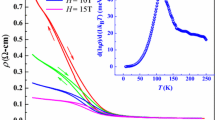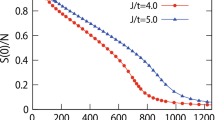Abstract
Based on several reports presented valence electron structure experimental results since the 1970s, a set of new itinerant electron models for typical magnetic materials were proposed to replace the conventional exchange interaction models. According to the new models, in this article, we investigate the temperature dependence relationship between the magnetization and resistivity of typical magnetic materials. At the ground state, valence electrons of the outer shell in an ion (or in an ionic core in a metal) move in a constant spin direction. When two approaching electrons with the same spin direction belong to two adjacent ions, they can exchange each other, to form itinerant electrons. When two approaching electrons with opposite spin directions belong to two adjacent ions, they cannot exchange each other; as a result, a Weiss electron pair (WEP) is formed with a specific probability and lifetime. The energy of WEPs serves as the origin of the magnetic ordering energy. With temperature increments, the spin direction of the itinerant electrons deviates from the ground state direction, increasing the resistivity of the materials; the spin directions of the electrons in a WEP deviate from the ground state direction, resulting in the magnetic ordering energy decreasing and, meanwhile, a decrease in the magnetization.






Similar content being viewed by others
References
Dai, D.S., Qian, K.M.: Ferromagnetism (in Chinese). Science Press, Beijing (1987)
Coey, J.M.D.: Magnetism and magnetic materials. Cambridge University Press, Cambridge (2010)
Chikazumi, S.: Physics of Ferromagnetism (2e). Oxford University Press, London (1997)
Stöhr, J., Siegmann, H.C.: Magnetism: From Fundamentals to Nanoscale Dynamics. Springer, Berlin Heidelberg, New York (2006)
Tang, G.D.: New Itinerant Electron Models of Magnetic Materials. Science Press, Beijing, and Springer Nature, Singapore (2021)
Tang, G.D., Li, Z.Z., Ma, L., Qi, W.H., Wu, L.Q., Ge, X.S., Wu, G.H., Hu, F.X.: Phys. Rep. 758, 1–56 (2018)
Xu, J., Ma, L., Li, Z.Z., Lang, L.L., Qi, W.H., Tang, G.D., Wu, L,Q., Xue, L.C,, Wu, G.H.: Physica. Status. Solidi. B. 252, 2820 (2015)
Wu, L.Q., Qi, W.H., Ge, X.S., Ji, D.H., Li, Z.Z., Tang, G.D., Zhong, W.: Europhys. Lett. 120, 27001 (2017)
Qi, W.H., Ma, L., Li, Z.Z., Tang, G.D., Wu, G.H.: Acta Phys. Sin. 66, 027101 (2017)
Qi, W.H., Li, Z.Z., Ma, L., Tang, G.D., Wu, G.H., Hu, F.X.: Acta. Phys. Sin. 66, 067501 (2017)
Qi, W.H., Li, Z.Z., Ma, L., Tang, G.D., Wu, G.: H. AIP Adv. 8, 065105 (2018)
Qian, J.J., Qi, W.H., Li, Z.Z., Ma, L., Tang, G.D., Du, Y.N., Chen, M.Y., Wu, G.H., Hu, F.X.: RSC Adv. 8, 4417–4425 (2018)
Li, Z.Z., Qi, W.H., Ma, L., Tang, G.D., Wu, G.H., Hu, F.X.: J. Magn. Magn. Mater. 482, 173–177 (2019)
Wijn, H.P.J.: Magnetic properties of Metals, Subvolume a. Springer-Verlag Berlin Heidelberg, Berlin, p120 (1986)
Fang, J.X., and Lu, D.: Solid state physics (in chinese). Shanghai Scientific and Technical Publishers, pp. 310–315 (1981)
Urushibara, A., Moritomo, Y., Arima, T., Asamitsu, A., Kido, G., Tokura, Y.: Phys. Rev. B 51, 14103 (1995)
Acknowledgements
The authors would like to thank Enago (www.enago.cn) for the English language review.
Funding
This work was supported by the National Natural Science Foundation of China (Grant No. NSF-11174069) and the Doctor Foundation of Hebei Normal University (L2022B10).
Author information
Authors and Affiliations
Corresponding author
Ethics declarations
Conflict of Interest
The authors declare no competing interests.
Additional information
Publisher's Note
Springer Nature remains neutral with regard to jurisdictional claims in published maps and institutional affiliations.
Appendices
Appendix 1. O 2p itinerant electron model for magnetic oxides (IEO model)
IEO model includes the following features [5, 6]:
-
(i)
In an oxide, O2− (2s22p6) and O1− (2s22p5) anions simultaneously coexist on the basis of experimental results for valence electron state. The outer orbit of an O1− anion has an O 2p hole. In a given sublattice, an O 2p electron with a constant spin direction can hop from an O2− anion to the O 2p hole of an adjacent O1− anion with a metal cation acting as an intermediary.
-
(ii)
Since an itinerant electron has a constant spin direction in a given sublattice, the two O 2p electrons in the outer orbit of an O2− anion, which have opposite spin directions, become itinerant electrons in two different sublattices. That is, in a magnetic oxide below Curie temperature, the itinerant electrons must have opposite spin directions in two sublattices, such as (A) or [B] sites of spinel ferrites.
-
(iii)
Subjected to the constraints of Hund’s rule and that an itinerant electron has a constant spin direction in a given sublattice, the magnetic moments of the cations with 3d electron numbers nd ≤ 4 (such as Mn3+ or divalent/trivalent Ti or Cr cations) are antiparallel to those of the cations with nd ≥ 5 (such as Mn2+ or divalent/trivalent Fe, Co, or Ni cations), regardless of whether they are located at the (A) or [B] sublattice.
Appendix 2. Itinerant electron model for magnetic metals (IEM model)
IEM model includes the following features [5, 6]:
-
(i)
Based on gamma radiation diffraction and other observations, in the process of forming a metal solid with a single-crystal or polycrystalline state from free atoms, most of the 4s electrons in 3d transition metals (except for Cu and Zn with a full 3d subshell) enter the 3d orbits to decrease the Pauli repulsive energy between atoms, while the remaining 4s electrons form free electrons.
-
(ii)
A certain probability exists that the outer orbital 3d electrons transit between the outer orbits of adjacent ionic cores, forming itinerant electrons. The other 3d electrons are local electrons.
-
(iii)
The resistivity of a metal decreases as the concentration of free electrons increases. The movements of free electrons are subjected by the weak crystal lattice potential field but not by the electron orbits, whose spins have no contribution to the material magnetic moment. The transition of the itinerant electrons is a spin-independent transition above the Curie temperature, but it is a spin-dependent transition below the Curie temperature, and the transition probability decreases with increasing test temperature and rapidly decreases near the Curie temperature.
Appendix 3. Weiss electron-pair (WEP) model for origin of magnetic ordering energy
WEP model includes the following features [5, 6]:
-
(i)
Supposing that a moving electron in an outer orbit of an ion has a constant spin direction, the electrons in the outer orbits of the adjacent ions, including the adjacent cations and anions in a compound and the ions (atoms that have lost free electrons) in a metal, may have three states, as shown in Fig. 7 a, b, and c.
-
(ii)
If the electrons have the state illustrated in Fig. 7a, there are two electrons with opposite spin directions in the outer orbit of each ion. The two electrons located between adjacent ions cannot be exchanged because they have opposite spin directions. The magnetic ordering energy is thus given by the difference between the static magnetic attractive energy and the Pauli repulsive energy of the two electrons. This type of electron pair, which has a particular lifetime and probability of appearing, is called a WEP.
-
(iii)
When the two electrons between adjacent ions have the state shown in Fig. 7b, both the static magnetic and Pauli repulsive energies exist between the two neighboring electrons, and they can be easily exchanged since they both have the same spin direction. When the electrons have the state depicted in Fig. 7c, the middle electron can easily transit to the outer orbit of the right ion. Thus, both the electron exchange in Fig. 7b and electron transit in Fig. 7c may be considered to be simply the transitions of itinerant electrons, wherein the spin directions of the itinerant electrons cannot change.
Rights and permissions
Springer Nature or its licensor (e.g. a society or other partner) holds exclusive rights to this article under a publishing agreement with the author(s) or other rightsholder(s); author self-archiving of the accepted manuscript version of this article is solely governed by the terms of such publishing agreement and applicable law.
About this article
Cite this article
Li, Z.Z., Qi, W.H., Ma, L. et al. Relationship Between the Magnetization and Resistivity of Typical Magnetic Materials. J Supercond Nov Magn 36, 685–692 (2023). https://doi.org/10.1007/s10948-023-06510-x
Received:
Accepted:
Published:
Issue Date:
DOI: https://doi.org/10.1007/s10948-023-06510-x





